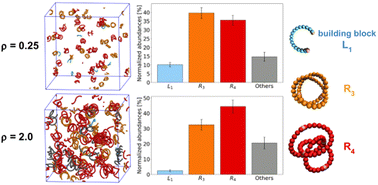Density-tunable pathway complexity in a minimalistic self-assembly model†
Abstract
An open challenge in self-assembly is learning how to design systems that can be conditionally guided towards different target structures depending on externally-controlled conditions. Using a theoretical and numerical approach, here we discuss a minimalistic self-assembly model that can be steered towards different types of ordered constructs at the equilibrium by solely tuning a facile selection parameter, namely the density of building blocks. Metadynamics and Langevin dynamics simulations allow us to explore the behavior of the system in and out of equilibrium conditions. We show that the density-driven tunability is encoded in the pathway complexity of the system, and specifically in the competition between two different main self-assembly routes. A comprehensive set of simulations provides insight into key factors allowing to make one self-assembling pathway prevailing on the other (or vice versa), determining the selection of the final self-assembled products. We formulate and validate a practical criterion for checking whether a specific molecular design is predisposed for such density-driven tunability of the products, thus offering a new, broader perspective to realize and harness this facile extrinsic control of conditional self-assembly.



 Please wait while we load your content...
Please wait while we load your content...